Verdict
An excellent DAC with a balanced and neutral approach to sound, the EarMen Eagle upgrades your music on whatever device you’re listening on at a relatively affordable price.
Pros
- Compact size
- Plug and play
- Balanced, neutral sound
- Good file compatibility
- Affordable upgrade
Cons
- A little too bombastic at higher volumes
Availability
- UKRRP: £109
- USARRP: $129
-
PlatformSupports Android, iOS, Mac and Windows -
AudioPlays up to 32-bit/384kHz in PCM, DXD and DSD
Introduction
Most people don’t realise that with a USB stick they could improve the sound of their mobile and desktop devices, but EarMen’s Eagle DAC/headphone amplifier has handed in its resume to supercharge your sound.
The Eagle supports playback from iOS, Android smartphones, Windows and Mac computers, covering a wide range of devices and file resolutions up to 384kHz.
Pocket-friendly and able to boost the sound for an array of devices. Is this DAC a hi-fi bargain?
Design
- Premium look (for a USB stick)
- Lightweight
- Feels robust
The Eagle’s USB appearance means it simply needs to be plugged into a source with a USB port and you’re off.
The glossy black enclosure is made from aluminium, which keeps it light at 15g, and with dimensions of 55 x 22 x 8 mm it’s eminently pocketable. If anything, it’s so small you could lose it if you’re not careful.
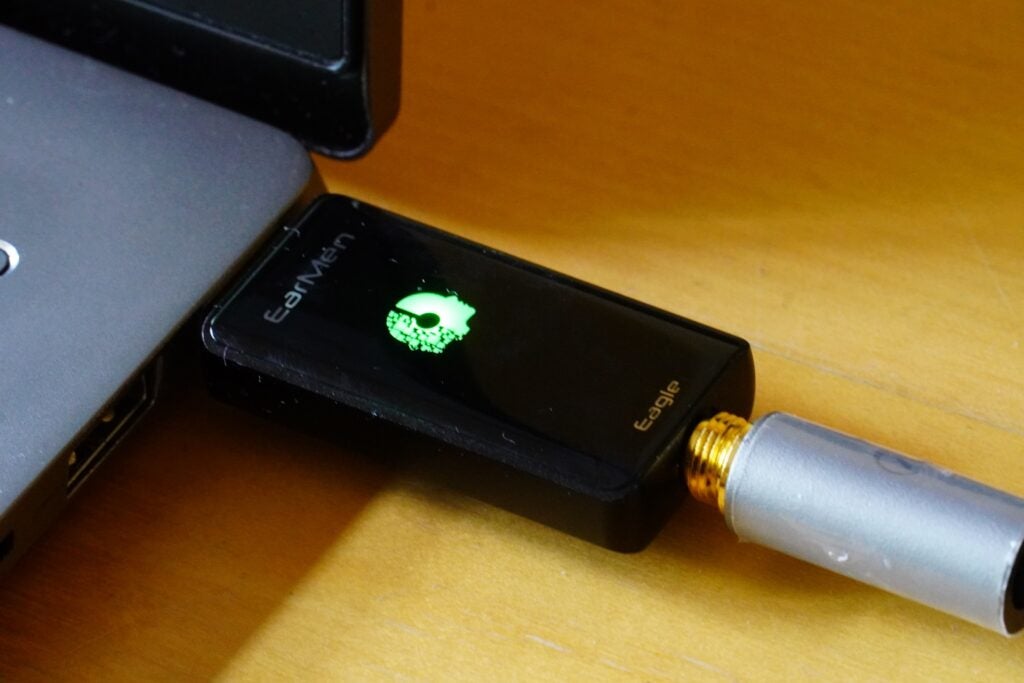
The face/headphone logo is an LED indicator that flickers into life when the Eagle has been plugged in. A white light means a connection has been made, red means it’s not connected, and green shows that either a PCM, DXD or DSD signal is being fed to the Eagle, while purple indicates MQA support for tracks such as those on the Tidal music streaming service.
At one end is a 3.5mm jack, and at the other end is the USB-A input with the option of adding a USB-A to C adapter. Small in size, this DAC/headphone amplifier looks more expensive than it is. And with a solid build quality, the Eagle should be able to withstand some buffeting and scrapes when carried around.
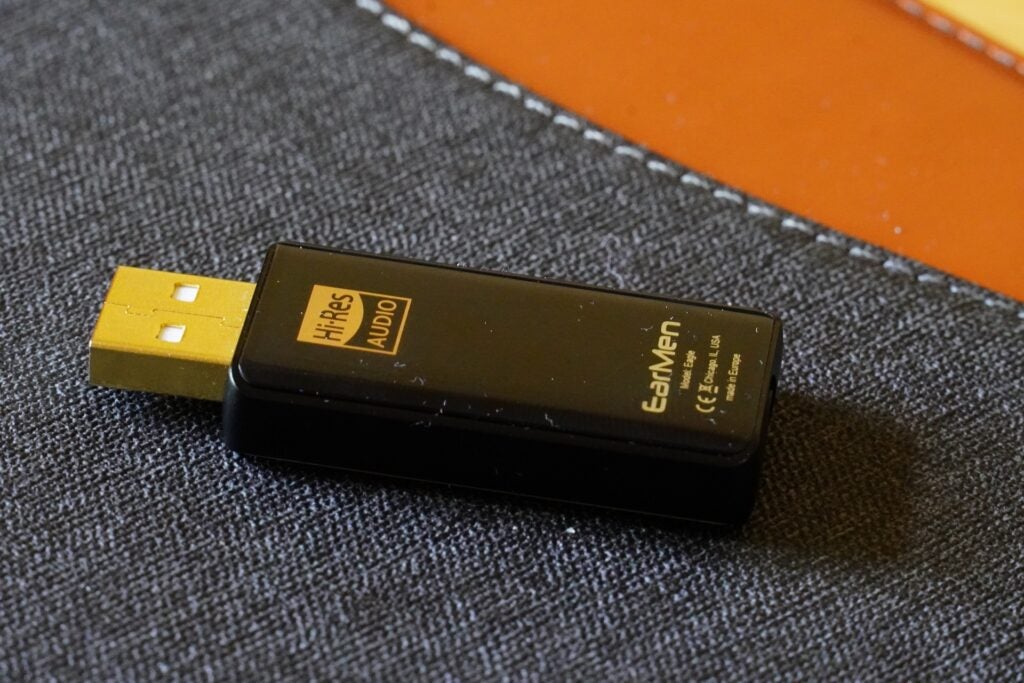
Features
- High-res support
- Low noise circuitry
- Wide support for sources
In terms of audio formats and resolutions, the EarMen Eagle can play PCM, DXD and DSD all the way to 32-bit/384kHz, 384/352.5 kHz and 64/128 DSD respectively, which means it can eat most high-resolution files for breakfast, lunch and dinner.
While it can play MQA content it’s not an MQA certified renderer as the more expensive Sparrow is, so it can’t unfold and unlock the extra information present in an MQA file beyond the initial unfold. You can read more about how MQA works here.
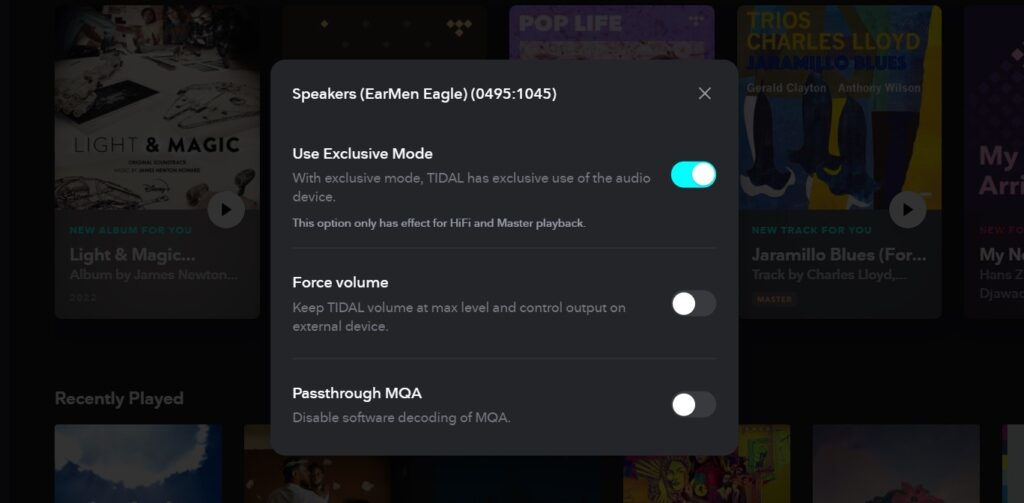
It achieves lift-off with High-Resolution Audio thanks to its ESS ES9280 C PRO DAC (digital audio converter), which EarMen claims provides Total Harmonic Distortion plus Noise (THD+N) figure of <0.002%. THD+N is the measurement of unintended harmonics that exists in a signal, and a measurement of less than 0.002% indicates that there’s very little noise present, which is what you want in the pursuit of sonic purity.
That’s further helped by Super LOW ESR tantal capacitors, which form the high-grade components in the power-supply design along with 4-layer golden plated PCB technology used in PCs and smartphones. Again, the goal here is to reduce signal noise.
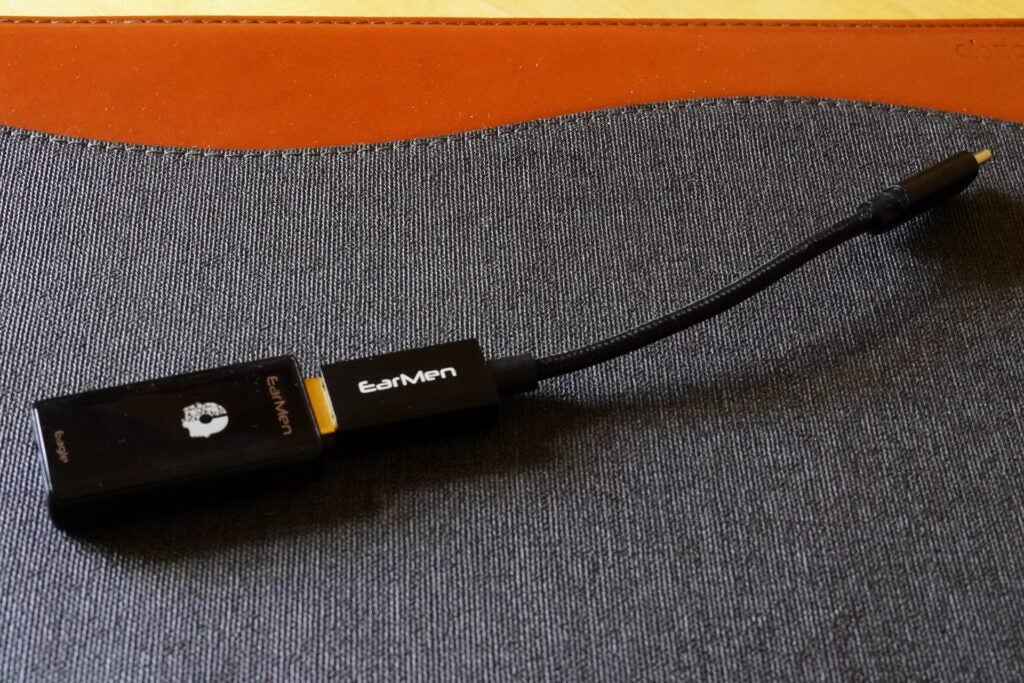
There’s a USB-C adapter included that works with my iPad Pro’s USB-C port, but for other iOS devices without USB-C, an Apple Lightning-to-USB adapter is needed. The USB-C works for Android devices too and you can use any USB OTG (On-the-Go) cable. There’s further support for MacOS and Windows PCs, so most, if not all avenues are covered.
Sound Quality
- Balanced performance
- Increased dynamic headroom
- Consistent performance across multiple sources
For this review I used the closed-backed Sivga Robin SV021 headphones with the Eagle DAC, listening to Qobuz and Tidal on a Lenovo laptop and an iPad Pro. The advantages of the EarMen Eagle are simple: the sound is clearer, bigger, more defined and with more depth over a plain headphone connection.
With a 24-bit/44.1kHz file of Gaal Leaves Synnax from Foundation: season one on Qobuz, the Eagle marks itself out as a clear, neutral and precise performer. There’s an extra ounce of sharpness and clarity across the frequency range, a finer feel for defining the track’s orchestral elements. The track’s dynamic range is also better showcased – bass is expressed with more purpose, while treble notes are brighter with more sparkle. The dynamic headroom of the Eagle offers music with more reach and impact.
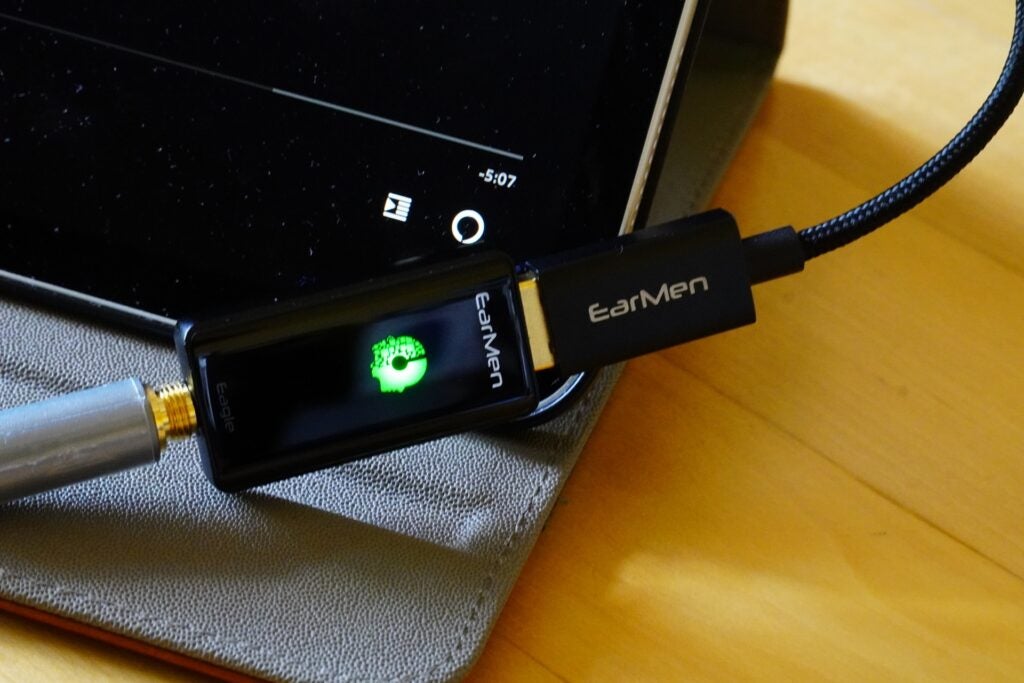
Similar conclusions are drawn from London Grammar’s California Soil (24-bit/44.1kHz). The bass is stronger and tighter in description with the Eagle; vocals occupy a bigger presence within the centre of the soundstage, with Hannah Reid’s voice being louder and supplied with more definition, sharpness and expression. It makes listening to the headphone’s output less colourful by comparison.
The detail that the Eagle finds is well above that of the laptop’s internal DAC, and that helps produce a stronger, better-defined stereo image. The Eagle does amp up the track’s sense of energy and attack though, perhaps a little too much, with the track’s booming bass overbearing at times and with voices a little thin and sparing in tone – there’s a little subtlety traded for energy and impact at higher volumes. If you find this is the case, the best solution is reducing the volume to more comfortable levels.
With Rey’s Theme from John Williams’ The Force Awakens there’s greater retrieval of detail of the orchestral instruments. The oboe that kicks things off is articulated and defined with wonderful clarity. The track’s sense of rhythmic flow is more engaging and fluid, the swells of orchestra as they shift gear from fast to slow carries more verve and momentum, emphasising the track’s peaks and troughs more confidently. It’s an altogether more incisive and neutral sounding performance than the smoothness of the laptop’s headphone output.
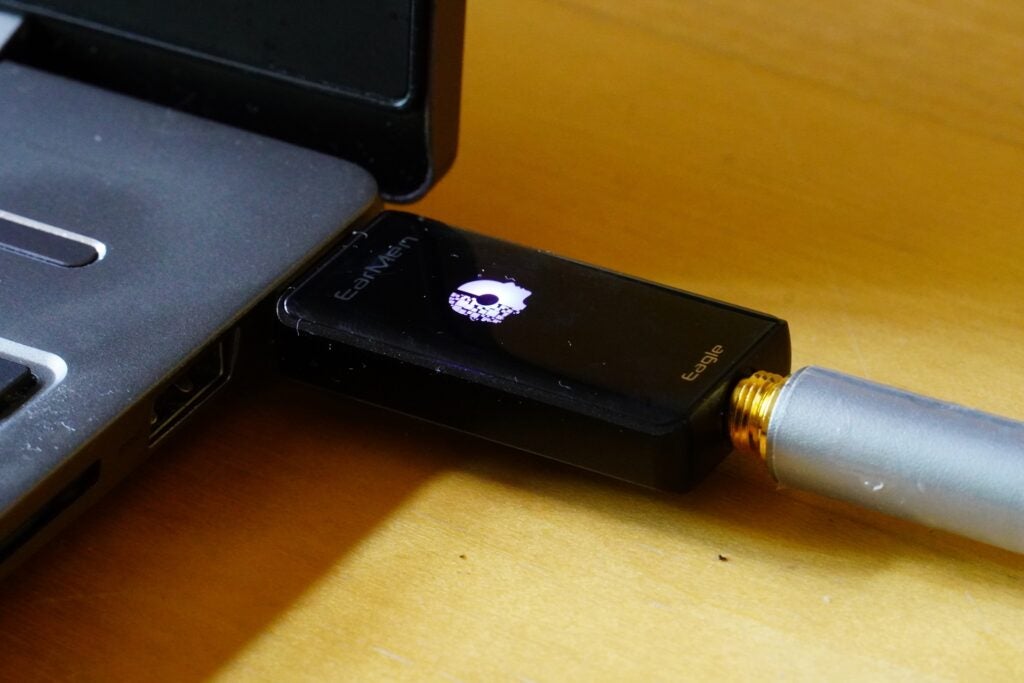
Moving to Tidal and Anderson Paak’s Fire in the Sky (Master), and everything mentioned before is transplanted here. Bass is more emphatic and weightier in its characterisation, the piano notes at the start of the track offer more brightness and variation in tone, along with Paak’s voice being larger and more expressive. It’s a balanced, coherent sound that conveys the song with greater nuance and fidelity.
To go back to this section’s opening paragraph, the Eagle’s attributes are simple and many: the sound is clearer, bigger, more defined and with more depth. As a simple and fairly affordable way of upgrading audio, the Eagle is an accomplished and entertainingly consistent means of doing so.
Latest deals
Should you buy it?
If you want a simple audio upgrade: Plug the EarMen Eagle and you’re on the way, retrieving more detail and clarity from your music than your home/mobile device’s internal DAC can muster.
For best quality MQA performance: The Eagle can play MQA tracks from Tidal, but it isn’t an MQA renderer like the more expensive Sparrow is. That grants its best playback when listening to Tidal and it’s worth considering if Tidal is your main music service.
Final Thoughts
Clarity, detail and neutrality – I can sum up the Eagle’s performance with those three words. Music is made even more enjoyable with the Eagle DAC, and with good device compatibility and file support, it’s a clear and sensibly priced upgrade. Whether you’re home or out of the house, this pocket-sized companion will make your music collection shine.
How we test
We test every DAC we review thoroughly. We use industry standard tests to compare features properly and we use the tablet as our main device over the review period. We’ll always tell you what we find and we never, ever, accept money to review a product.
Find out more about how we test in our ethics policy.
Tested across several months
Tested with hi-res audio streaming services
FAQs
The Eagle comes with a USB-C adaptor, so it works out of the box with iOS devices such as the iPad Pro, but for devices with a lightning connector, you will need the Lightning Camera Adaptor to connect the Eagle.
The Eagle can play Tidal Masters tracks but it doesn’t have full support for Master tracks like the more expensive Sparrow DAC does.
Jargon buster
Hi-Res Audio
Hi-Res audio is referred to as a standard as well as a marketing term that describes digital audio files of better-than-CD quality (16-bit/44.1kHz).
Verdict
An excellent DAC with a balanced and neutral approach to sound, the EarMen Eagle upgrades your music on whatever device you’re listening on at a relatively affordable price.
Pros
- Compact size
- Plug and play
- Balanced, neutral sound
- Good file compatibility
- Affordable upgrade
Cons
- A little too bombastic at higher volumes
Availability
- UKRRP: £109
- USARRP: $129
-
PlatformSupports Android, iOS, Mac and Windows -
AudioPlays up to 32-bit/384kHz in PCM, DXD and DSD
Introduction
Most people don’t realise that with a USB stick they could improve the sound of their mobile and desktop devices, but EarMen’s Eagle DAC/headphone amplifier has handed in its resume to supercharge your sound.
The Eagle supports playback from iOS, Android smartphones, Windows and Mac computers, covering a wide range of devices and file resolutions up to 384kHz.
Pocket-friendly and able to boost the sound for an array of devices. Is this DAC a hi-fi bargain?
Design
- Premium look (for a USB stick)
- Lightweight
- Feels robust
The Eagle’s USB appearance means it simply needs to be plugged into a source with a USB port and you’re off.
The glossy black enclosure is made from aluminium, which keeps it light at 15g, and with dimensions of 55 x 22 x 8 mm it’s eminently pocketable. If anything, it’s so small you could lose it if you’re not careful.

The face/headphone logo is an LED indicator that flickers into life when the Eagle has been plugged in. A white light means a connection has been made, red means it’s not connected, and green shows that either a PCM, DXD or DSD signal is being fed to the Eagle, while purple indicates MQA support for tracks such as those on the Tidal music streaming service.
At one end is a 3.5mm jack, and at the other end is the USB-A input with the option of adding a USB-A to C adapter. Small in size, this DAC/headphone amplifier looks more expensive than it is. And with a solid build quality, the Eagle should be able to withstand some buffeting and scrapes when carried around.

Features
- High-res support
- Low noise circuitry
- Wide support for sources
In terms of audio formats and resolutions, the EarMen Eagle can play PCM, DXD and DSD all the way to 32-bit/384kHz, 384/352.5 kHz and 64/128 DSD respectively, which means it can eat most high-resolution files for breakfast, lunch and dinner.
While it can play MQA content it’s not an MQA certified renderer as the more expensive Sparrow is, so it can’t unfold and unlock the extra information present in an MQA file beyond the initial unfold. You can read more about how MQA works here.

It achieves lift-off with High-Resolution Audio thanks to its ESS ES9280 C PRO DAC (digital audio converter), which EarMen claims provides Total Harmonic Distortion plus Noise (THD+N) figure of <0.002%. THD+N is the measurement of unintended harmonics that exists in a signal, and a measurement of less than 0.002% indicates that there’s very little noise present, which is what you want in the pursuit of sonic purity.
That’s further helped by Super LOW ESR tantal capacitors, which form the high-grade components in the power-supply design along with 4-layer golden plated PCB technology used in PCs and smartphones. Again, the goal here is to reduce signal noise.

There’s a USB-C adapter included that works with my iPad Pro’s USB-C port, but for other iOS devices without USB-C, an Apple Lightning-to-USB adapter is needed. The USB-C works for Android devices too and you can use any USB OTG (On-the-Go) cable. There’s further support for MacOS and Windows PCs, so most, if not all avenues are covered.
Sound Quality
- Balanced performance
- Increased dynamic headroom
- Consistent performance across multiple sources
For this review I used the closed-backed Sivga Robin SV021 headphones with the Eagle DAC, listening to Qobuz and Tidal on a Lenovo laptop and an iPad Pro. The advantages of the EarMen Eagle are simple: the sound is clearer, bigger, more defined and with more depth over a plain headphone connection.
With a 24-bit/44.1kHz file of Gaal Leaves Synnax from Foundation: season one on Qobuz, the Eagle marks itself out as a clear, neutral and precise performer. There’s an extra ounce of sharpness and clarity across the frequency range, a finer feel for defining the track’s orchestral elements. The track’s dynamic range is also better showcased – bass is expressed with more purpose, while treble notes are brighter with more sparkle. The dynamic headroom of the Eagle offers music with more reach and impact.

Similar conclusions are drawn from London Grammar’s California Soil (24-bit/44.1kHz). The bass is stronger and tighter in description with the Eagle; vocals occupy a bigger presence within the centre of the soundstage, with Hannah Reid’s voice being louder and supplied with more definition, sharpness and expression. It makes listening to the headphone’s output less colourful by comparison.
The detail that the Eagle finds is well above that of the laptop’s internal DAC, and that helps produce a stronger, better-defined stereo image. The Eagle does amp up the track’s sense of energy and attack though, perhaps a little too much, with the track’s booming bass overbearing at times and with voices a little thin and sparing in tone – there’s a little subtlety traded for energy and impact at higher volumes. If you find this is the case, the best solution is reducing the volume to more comfortable levels.
With Rey’s Theme from John Williams’ The Force Awakens there’s greater retrieval of detail of the orchestral instruments. The oboe that kicks things off is articulated and defined with wonderful clarity. The track’s sense of rhythmic flow is more engaging and fluid, the swells of orchestra as they shift gear from fast to slow carries more verve and momentum, emphasising the track’s peaks and troughs more confidently. It’s an altogether more incisive and neutral sounding performance than the smoothness of the laptop’s headphone output.

Moving to Tidal and Anderson Paak’s Fire in the Sky (Master), and everything mentioned before is transplanted here. Bass is more emphatic and weightier in its characterisation, the piano notes at the start of the track offer more brightness and variation in tone, along with Paak’s voice being larger and more expressive. It’s a balanced, coherent sound that conveys the song with greater nuance and fidelity.
To go back to this section’s opening paragraph, the Eagle’s attributes are simple and many: the sound is clearer, bigger, more defined and with more depth. As a simple and fairly affordable way of upgrading audio, the Eagle is an accomplished and entertainingly consistent means of doing so.
Latest deals
Should you buy it?
If you want a simple audio upgrade: Plug the EarMen Eagle and you’re on the way, retrieving more detail and clarity from your music than your home/mobile device’s internal DAC can muster.
For best quality MQA performance: The Eagle can play MQA tracks from Tidal, but it isn’t an MQA renderer like the more expensive Sparrow is. That grants its best playback when listening to Tidal and it’s worth considering if Tidal is your main music service.
Final Thoughts
Clarity, detail and neutrality – I can sum up the Eagle’s performance with those three words. Music is made even more enjoyable with the Eagle DAC, and with good device compatibility and file support, it’s a clear and sensibly priced upgrade. Whether you’re home or out of the house, this pocket-sized companion will make your music collection shine.
How we test
We test every DAC we review thoroughly. We use industry standard tests to compare features properly and we use the tablet as our main device over the review period. We’ll always tell you what we find and we never, ever, accept money to review a product.
Find out more about how we test in our ethics policy.
Tested across several months
Tested with hi-res audio streaming services
FAQs
The Eagle comes with a USB-C adaptor, so it works out of the box with iOS devices such as the iPad Pro, but for devices with a lightning connector, you will need the Lightning Camera Adaptor to connect the Eagle.
The Eagle can play Tidal Masters tracks but it doesn’t have full support for Master tracks like the more expensive Sparrow DAC does.
Jargon buster
Hi-Res Audio
Hi-Res audio is referred to as a standard as well as a marketing term that describes digital audio files of better-than-CD quality (16-bit/44.1kHz).

























